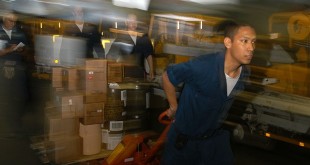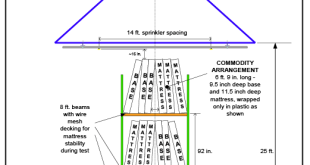In this issue, I want to discuss a situation in which I worry many of our members place themselves unknowingly. The design question my technical team receives most often involves the determination of a hazard classification or system design parameters for a specific occupancy, storage arrangement, or process. These questions typically involve non-typical tenant spaces, combustible or flammable liquids, lithium-ion batteries, automated storage methods, open-top containers, car stackers, boat hotels, portable storage containers, cantabiles production, slope ceilings in a storage occupancy, or similar topics. Now the question that needs to be asked is, “What do all these topics have in common?” The answer to that question is easy, but our members typically do not like to hear it. These hazards are outside the scope of NFPA 13, Standard for the Installation of Sprinkler Systems.
I know the response I will receive from the member, as I hear it all the time is, “Great, but we need an answer. The general contractor has said we have to figure it out and quote accordingly.” Sound familiar? We all want to have the answers. As contractors, you spend hours researching, reading the standards, calling colleagues, or asking your trade association for assistance. And where possible, our staff gladly assists. However, we will never be afraid to tell you this is outside the scope of the referenced standard and the fact that, in most cases, this is not your responsibility. In most cases, you can be held liable for practicing engineering without a license.1
The Society of Fire Protection Engineers (SFPE) has a position statement on the roles and responsibilities of engineers and technicians, PS 2020-1 “The Engineer and the Technician Designing Fire Protection Systems” (October 21, 2020). It is available on the SFPE website, or you can search for it using “Position Statement 2020-1 SFPE.” This is a must-read for any person in designing, engineering, specifying, reviewing, or approving a water-based fire protection system. AFSA, and many other organizations you will recognize, endorsed this position paper. This document has been called the standard of practice by many legal professionals. When layout technicians venture outside their area of specific expertise or practice outside the referenced standard requirements or guidelines, they could be practicing engineering. If they are not properly licensed, they could open themselves and their employer to liability. I know most contractors do not have a professional engineer on staff or retainer to work with them, and, unfortunately, many professional engineers are not skilled in our industry. However, there are professional engineers who can perform this work. Either put this decision responsibility on the owner, where I believe it should be, or take it upon yourself with additional guidance as needed by a professional engineer and with the correct compensation for the increase in liability exposure.
I also hear, “When will NFPA 13 address this hazard or that storage arrangement?” The answer is simple, “When the NFPA technical committee receives a public input with supporting data to change the standard.” Data is the important piece. Many technical committee members submit public inputs to modify the standard, but without proper supporting data, the public inputs do not make it far in the process. Items like those above are anyone’s guess on how to properly protect them. Just like you, I would like answers. However, I only have my training and experience to base decisions. Data is needed.
Data can come from many sources. How can the industry obtain more data? Usually, a group of interested persons and companies come together to form a research project to study a particular hazard. Organizations like NFPA’s Fire Protection Research Foundation, where I serve on the Board of Trustees, often lead the effort. The resulting reports can provide for changes to the referenced standards. So, why don’t these organizations handle these needs in a timelier manner? Again, the answer is simple—resources, specifically financial resources. It takes money to study, obtain materials, and conduct testing, including real fire burn tests.
For a specific example, one issue that has been front and center is automotive parking structures. Modern vehicles are different from the ones your grandparents drove. Today’s vehicles contain much more plastics. Some include electrical storage systems and less non-combustible components. Who knows what vehicles will look like in the next decade or two? The method of storage is also different. As available space diminishes, parking density has increased. Vehicles are stacked vertically on top of each other or pushed horizontally close together.
NFPA’s Research Foundation has completed Part 1 of a research study titled “Modern Vehicle Hazards in Parking Garages and Vehicle Carriers.”2 It is a good read, but additional research is needed before we have direction on how to properly protect a modern parking garage. Part 2 of this research is being planned. Interested parties and companies are being approached about sponsorship opportunities. AFSA has funded research in the past and will continue to do so where we have the resources and feel the investment will produce results that can be used to change the referenced standards and provide answers to questions that are out of the scope of a standard. Ultimately, this will result in better fire protection and benefits our membership. Let me know what you think.
REFERENCES:
ABOUT THE AUTHOR: John August Denhardt, P.E., ET, FSFPE, CWBSP, is Vice President of Engineering and Technical Services for AFSA. He is responsible for strengthening AFSA’s engineering and technical approaches to meeting member, industry, and operational priorities, emphasizing service, quality, and integrity. Denhardt is a Professional Engineer (P.E.) registered in the District of Columbia and the states of Delaware, Maryland, Pennsylvania, and Virginia. He is a NICET Level III in Water-Based Systems Layout, a NICET Level III in Inspection and Testing of Water-Based Systems, and an NFPA Certified Water-Based Systems Professional (CWBSP). Denhardt is a member of the NFPA 13 Sprinkler Discharge Committee, a Fellow of the Society of Fire Protection Engineers (SFPE), a member of the SFPE Board of Directors, a member of the Board of Trustees for NFPA’s Fire Protection Research Foundation and sits on the University of Maryland Department of Fire Protection Engineering’s Board of Visitors. A native of Maryland, Denhardt holds a Bachelor of Science degree in Fire Protection Engineering from the University of Maryland in College Park.
 Sprinkler Age A Publication of the American Fire Sprinkler Association
Sprinkler Age A Publication of the American Fire Sprinkler Association



